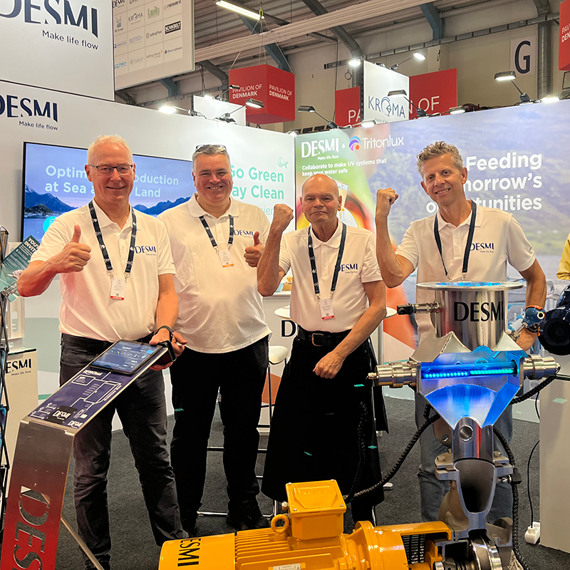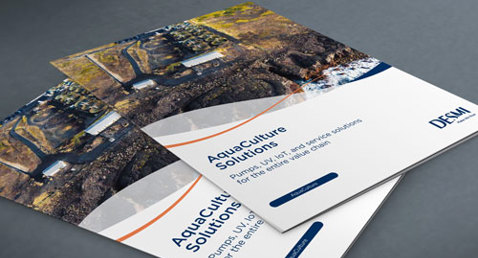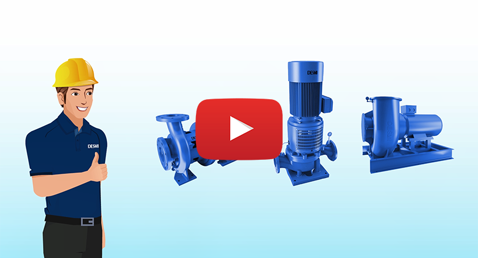Vertical Pumps
Vertical pumps are essential in modern fish farming, where space is tight, uptime is critical, and water quality can’t be compromised. At DESMI, we design vertical pumping solutions that meet these demands head-on - combining high flow performance with energy efficiency and minimal maintenance.
Whether you’re managing a land-based RAS facility or an offshore operation, our vertical centrifugal pumps offer flexible installation, corrosion-resistant materials, and robust engineering trusted by aquaculture producers worldwide.
Why vertical pumps are ideal for Aquaculture systems
In aquaculture, pump reliability isn’t a luxury - it’s a necessity. Water must circulate constantly to support filtration, oxygenation, and stable water temperatures. Vertical pumps meet these demands better than most other pump types due to their efficient hydraulic performance, compact design, and ease of integration into complex piping systems.
Their vertical orientation minimizes the system footprint, which is especially valuable in space-constrained fish farms or multi-tank hatchery setups. And because the inlet and outlet are vertically aligned, piping is simpler, installation is faster, and energy losses due to direction changes are reduced - all critical in systems that run 24/7.
Unlike horizontal pumps, vertical models are easier to maintain in tight mechanical rooms and often provide better suction conditions, making them ideal for large-volume water transfer at low heads - exactly what’s needed in recirculating aquaculture systems (RAS), flow-through systems, and well boats.
Engineered for Aquaculture environments
Vertical centrifugal pumps from DESMI are developed specifically to meet the harsh and variable conditions of fish farming. They’re constructed using materials like Super Duplex stainless steel or ceramic-coated cast iron, making them resistant to saltwater corrosion and temperature fluctuations.
They also run quietly, with low vibration - critical in systems where noise can stress fish and affect growth rates. Long service intervals, combined with high hydraulic efficiency, ensure uptime, reduce energy costs, and keep operations running smoothly across diverse aquaculture systems.

Key benefits of using a vertical centrifugal pump in fish farming
Aquaculture systems are sensitive, high-performance environments - and they demand equipment that matches that standard. Vertical centrifugal pumps stand out by combining hydraulic precision with long-term reliability, helping fish farms maintain optimal water quality with minimal disruption.
- High flow at low pressure
Vertical centrifugal pumps are designed to move large volumes of water efficiently, making them ideal for intake lines, recirculation loops, and filtration systems where gentle, continuous flow is essential.
- Low vibration and noise levels
Engineered to run quietly and smoothly, these pumps help maintain a stable environment where fish can thrive - reducing stress and supporting better growth rates.
-
Exceptional energy efficiency
Engineered to run quietly and smoothly, these pumps help maintain a stable environment where fish can thrive - reducing stress and supporting better growth rates.
- Built for seawater and long service life
Made with corrosion-resistant materials such as Super Duplex and ceramic-coated cast iron, vertical centrifugal pumps are tough enough for harsh saltwater conditions and require minimal maintenance over time.
Choosing the right vertical multistage pump for Aquaculture operations
Selecting the right pump isn’t just about flow and pressure - it’s about long-term system performance, uptime, and compatibility with the unique demands of your aquaculture setup. Whether you're designing a new facility or upgrading an existing installation, vertical multistage pumps offer the flexibility and efficiency needed to meet complex operational requirements.

NSLV - Vertical Installation
In high-capacity systems or those with long pipe runs, vertical multistage pumps can maintain pressure without increasing the footprint. This is especially valuable in land-based RAS facilities, where space is limited and flow demands are high.
Material selection is also key. Salinity, temperature, and water chemistry vary significantly across operations. With pump configurations available in Super Duplex stainless steel and ceramic-coated cast iron, DESMI ensures resistance to corrosion and long service life in both freshwater and seawater environments.
For operators seeking better control and predictive maintenance, DESMI’s IoT-enabled solutions allow real-time monitoring of pressure, vibration, and temperature. This not only extends the life of the equipment but also simplifies servicing and reduces the risk of unplanned downtime.
Ultimately, the right vertical pump is one that fits your current system and supports your future growth - efficiently, reliably, and with minimal maintenance.

How vertical pumps enhance water circulation in Aquaculture systems
Water circulation is the backbone of every aquaculture system - and vertical pumps play a key role in ensuring that movement is continuous, balanced, and energy-efficient. From recirculating aquaculture systems (RAS) to flow-through setups, vertical pumps help maintain the conditions fish need to grow and thrive.
By delivering high flow at low pressure, vertical pumps keep water moving steadily through biofilters, oxygenation units, degassing columns, and UV systems - without creating damaging turbulence or flow dead zones. This consistent movement ensures even distribution of oxygen, stable temperatures, and effective waste removal throughout the system.
Their vertical orientation also simplifies integration into compact plant layouts. Because the suction and discharge ports are aligned vertically, water flows more directly - reducing energy loss, improving efficiency, and lowering operating costs over time.
In systems using UV disinfection or ozone dosing, vertical pumps help maintain the exact flow rates needed for effective treatment - making them essential for pathogen control in high-density farming environments.
In short, vertical pumps don’t just move water - they help create the controlled, stable conditions aquaculture systems rely on to keep fish healthy and operations running smoothly.

FAQ
What is a vertical pump?
A vertical pump is a centrifugal pump mounted vertically, with the motor positioned above the pump and the impeller submerged in the fluid. This design saves floor space and allows for efficient fluid handling in systems where horizontal space is limited.
What is a vertical centrifugal pump?
A vertical centrifugal pump uses a rotating impeller to move water and is configured in a vertical alignment. It's commonly used in aquaculture due to its compact footprint, energy efficiency, and ability to handle large flow rates at low pressure.
What is a vertical multistage pump?
A vertical multistage pump features multiple impellers stacked in a series, allowing it to build higher pressure while maintaining steady flow. It's ideal for applications that require increased head, such as long pipe runs or elevated discharge points in aquaculture systems.
How does a vertical pump work?
Vertical pumps draw water in from below and use centrifugal force to push it upward through the discharge pipe. The design minimizes turbulence and offers smooth, continuous flow, which is essential for stable water conditions in fish farming.
Why choose vertical pumps for aquaculture?
Vertical pumps are energy-efficient, space-saving, and designed for continuous operation - making them ideal for aquaculture environments. They support critical processes like recirculation, filtration, and oxygenation while reducing noise, vibration, and maintenance needs.
How do I maintain vertical pumps?
Vertical pumps require regular inspection of seals, bearings, and impellers. DESMI vertical pumps are designed for easy service access, helping reduce downtime. Preventive maintenance and condition monitoring (e.g., via DESMICloud) can extend the life of the pump and avoid costly breakdowns.


